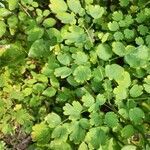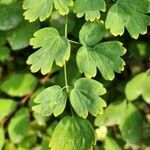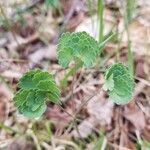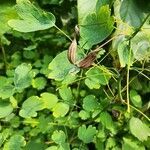Roots yellow to medium brown or black, thin, fibrous. Stems erect, 30-100(-120) dm, glabrous, often from well-developed rhizomes. Leaves mostly cauline. Leaf blade 3-4×-ternately compound; leaflets orbiculate to obovate-cuneate or cordate, apically 3-lobed, 10-30 mm wide, lobe margins coarsely crenate, surfaces glabrous to glandular. Inflorescences terminal (some flowers in axils of distal leaves), panicles, rather open, many flowered. Flowers: sepals whitish or greenish or purplish tinged, ovate, 3.5-4.4 mm in staminate flowers, 1.5-2 mm in pistillate flowers; filaments purplish, 4-10 mm; anthers 1.5-4 mm, long-apiculate; stigma often purplish. Achenes 6-9, spreading to reflexed, short-stipitate; stipe 0.4-1.2 mm; body fusiform, not laterally compressed, (4-)6-9(-10) mm, tapering at both ends, glandular, strongly 3-veined on each side, veins not anastomosing; beak 3-4.5(-6) mm.
More
A herb. It grows 30-100 cm tall. It has rhizomes or underground stems. Young leaves are purplish. The leaves have 3-4 leaflets and these have rounded lobes at the end. The leaves are 1-3 cm long. Male and female flowers are on separate plants. There are several greenish flowers.




